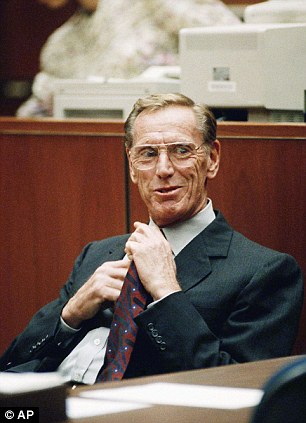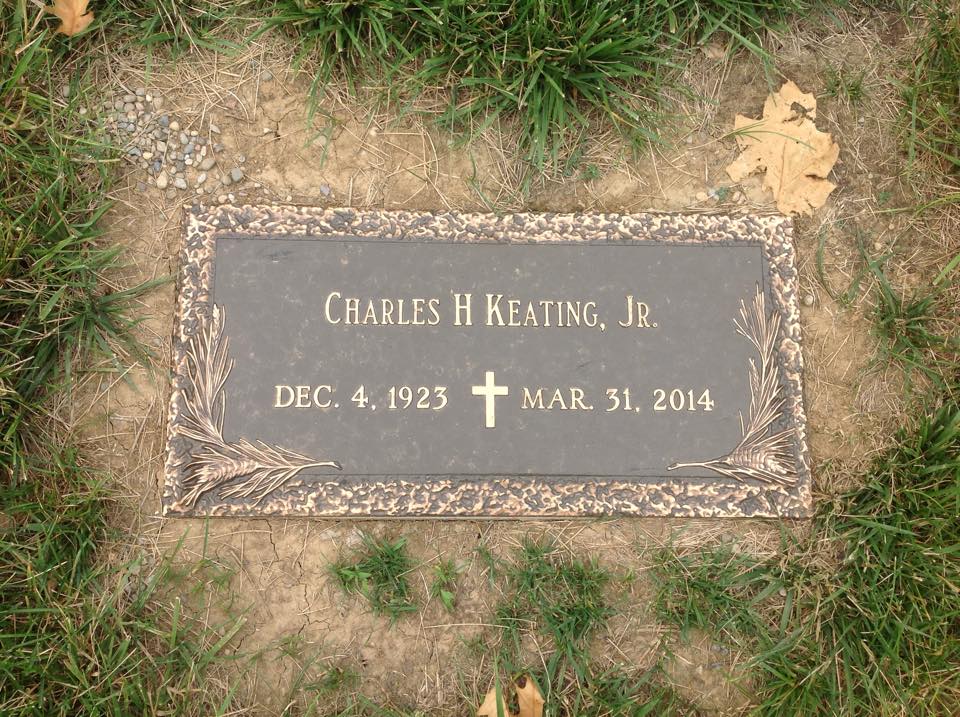Charles Keating JR (Charles Humphrey Keating, Jr.)

Charles Keating JR
Charles H. Keating Jr., who went to prison and came to symbolize the $150 billion savings-and-loan crisis a generation ago after fleecing thousands of depositors with regulatory help from a group of United States senators known as the Keating Five, has died. He was 90.
The death was confirmed Tuesday night by his son-in-law Gary Hall, who provided no other details. The Los Angeles Times quoted another son-in-law, Bradley J. Boland, as saying that Mr. Keating died late Monday in a hospital in Phoenix, where he had lived since 1976.
The S.&L. debacle of the 1980s and ’90s, when a thousand institutions collapsed in an implosion of reckless investments, may be a distant echo in a nation struggling to recover from more recent economic turmoil. But to millions old enough to have been dragged through the mess, Mr. Keating is remembered, perhaps unjustly, as the pre-eminent villain of an era when depositors, many of them older Americans and naïve investors, lost life savings in hometown thrifts that they thought were safe.
Mr. Keating, who pleaded guilty to fraud charges, had been a young man of promise — a Navy flier during World War II, an All-American swimmer in college, the leader of a national campaign against pornography, a blustery Cincinnati lawyer and businessman whose brother was an Ohio congressman.
But in 1984, Mr. Keating, then a 61-year-old Phoenix real estate millionaire, bought Lincoln Savings & Loan, of Irvine, Calif., for $51 million, double its net worth. Lincoln, with 26 branches, made small profits on home loans, but under new state and federal rules it could make riskier investments, and Mr. Keating began pouring depositors’ savings into real estate ventures, stocks, junk bonds and other high-yield instruments.
In three years, Lincoln’s assets soared to $3.9 billion, from $1 billion, and Mr. Keating was using the business as his personal cash machine, taking $34 million for himself and his family and $1.3 million more for political contributions, prosecutors said.
The Federal Home Loan Bank Board, fearing wide collapses in a shaky industry, finally imposed a 10 percent limit on risky S.&L. investments. By 1987, its investigators found that Lincoln had $135 million in unreported losses and was more than $600 million over the risky-investment ceiling. Soon, the F.B.I., the Securities and Exchange Commission and other agencies were homing in.
Mr. Keating hired Alan Greenspan, soon to be chairman of the Federal Reserve, who compiled a report saying Lincoln’s depositors faced “no foreseeable risk” and praising a “seasoned and expert” management. Mr. Keating soon called on five senators who had been recipients of his campaign largess — Alan Cranston of California, Donald W. Riegle Jr. of Michigan, John Glenn of Ohio and Dennis DeConcini and John McCain of Arizona — to pressure the bank board to relax its rules and kill its investigation.
All five met with regulators, and Edwin J. Gray, then the board chairman, said four of the senators — all but Mr. Riegle — “came to me like lawyers arguing for a client.” He resisted, but was replaced by a chairman more sympathetic to Mr. Keating, and the board backed off, with disastrous results for depositors and investors.
Lincoln survived for two more years. On the books, assets ballooned to $5.46 billion, but billions were in speculative investments, and hidden losses soared. Lincoln talked many customers into replacing federally insured deposits with high-yielding bonds from Lincoln’s parent, American Continental, a Keating corporation that was drowning in losses.
Bond buyers were not told the condition of American Continental, or that its bonds were uninsured, prosecutors said. A witness in a lawsuit years later produced a Lincoln memo advising its bond salesmen to remember that “the weak, meek and ignorant are always good targets.”
American Continental went bankrupt in 1989, and an insolvent Lincoln was seized by the government. Some 23,000 customers were left holding $250 million in worthless bonds, the life savings of many, and taxpayers paid $3.4 billion to cover Lincoln’s losses. It was the largest of 1,043 S.&L. failures from 1986 to 1995. Authoritative studies show that they cost the savings and loan industry $29 billion and taxpayers $124 billion. The government sued Mr. Keating for $1.1 billion, but he said he was broke.
Convicted of fraud, racketeering and conspiracy in state and federal trials, Mr. Keating went to prison for four and a half years. Both verdicts were overturned on appeals in 1996. California dropped its case, and on the eve of a federal retrial in 1999, Mr. Keating, who always insisted he had done nothing wrong, pleaded guilty to four counts of wire and bankruptcy fraud and was sentenced to time already served.
The Keating Five — all Democrats except Mr. McCain — also insisted they had done nothing improper. The Senate Ethics Committee concluded in 1991 that none had violated laws, but it said that Senators Cranston, DeConcini and Riegle had interfered with the bank board’s inquiry and rebuked them, Mr. Cranston in the harshest terms. Senator Glenn and Senator McCain were cleared, but criticized for “poor judgment.”
Mr. Keating, a 6-foot-5-inch beanpole who walked with a swagger, never minced words about buying political influence. Asked once whether his payments to politicians had worked, he told reporters, “I want to say in the most forceful way I can: I certainly hope so.”
Charles Humphrey Keating Jr. was born in Cincinnati on Dec. 4, 1923. He attended Catholic schools and was an accomplished swimmer. He joined the Navy in World War II and became a fighter pilot but was never deployed to a combat theater. After the war, he enrolled in law school at the University of Cincinnati, won various collegiate swimming championships and was named an All-American. In 1948, he received a law degree and began practice in Cincinnati.
In 1949, he married the former Mary Elaine Fette. They had five daughters and a son. In the 1950s, Mr. Keating organized Catholic men’s groups to fight pornography and founded Citizens for Decent Literature, which under various names grew to 300 chapters and 100,000 members nationally. He became known as a stern moralist, and in 1969 was named by Richard M. Nixon to the President’s Commission on Obscenity and Pornography.
With his brother, William, Mr. Keating founded a law firm in 1952. (William was a congressman from 1971 to 1974 and later chairman of The Cincinnati Enquirer.) By the late 1950s, the law firm’s principal client was Carl H. Lindner Jr., a businessman who formed American Financial Corporation in 1960 as a sprawling conglomerate. Mr. Keating left law practice in 1972 to become American Financial’s executive vice president.
In the 1970s, the S.E.C. accused American Financial of irregularities; Mr. Lindner and Mr. Keating admitted no wrongdoing but agreed to violate no fraud statutes. After a falling-out with Mr. Lindner, Mr. Keating moved to Phoenix in 1976 to run American Continental, a real estate spinoff he acquired from American Financial. By the early 1980s, it was a major home builder in Phoenix and Denver.
Mr. Keating thus acquired millions just as the government lifted rules that had long limited the scope of investments that S.&L.s could make with depositors’ money. Lincoln became a cash cow for Mr. Keating’s investments, prosecutors said, and its failure was a metaphor for an age of excess.
In Phoenix he had worked occasionally as a real estate consultant. In their book, “Trust Me: Charles Keating and the Missing Billions” (1993), Michael Binstein and Charles Bowden wrote: “He did not simply rob a bank. He broke a bank with his dreams.”
Born
- December, 04, 1923
- Cincinnati, Ohio
Died
- March, 31, 2014
- Phoenix, Arizona
Cause of Death
- an undisclosed illness
Cemetery
- Gate of Heaven Cemetery
- Montgomery, Ohio


